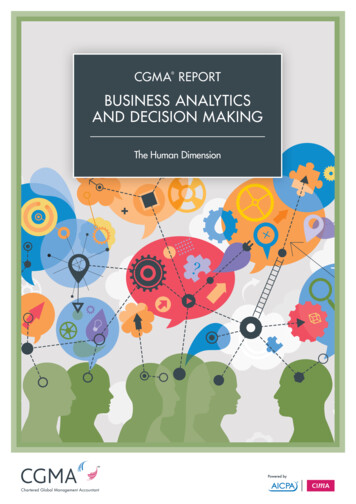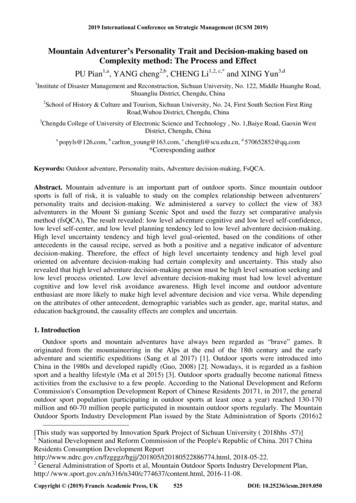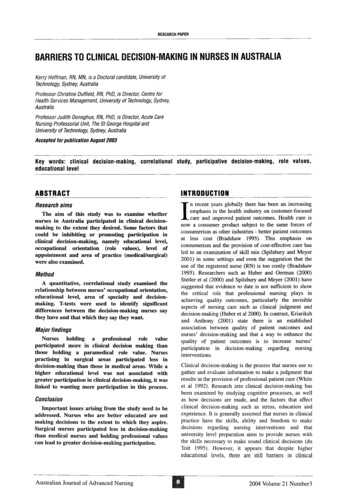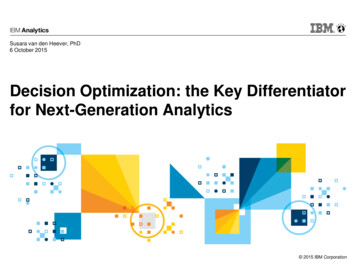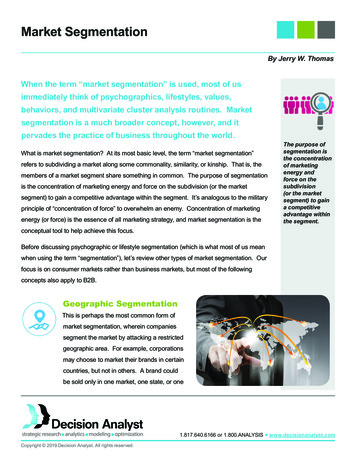
Transcription
Permitting decisionsBespoke permitWe have decided to grant the permit for Spring Park Data Centre operated by Ark Data Centres Limited.The permit number is EPR/PP3003PW.We consider in reaching that decision we have taken into account all relevant considerations and legalrequirements and that the permit will ensure that the appropriate level of environmental protection isprovided.Purpose of this documentThis decision document provides a record of the decision making process. It: highlights key issues in the determination summarises the decision making process in the decision checklist to show how all relevant factorshave been taken into account shows how we have considered the consultation responses.Unless the decision document specifies otherwise we have accepted the applicant’s proposals.Read the permitting decisions in conjunction with the environmental permit. The introductory notesummarises what the permit covers.EPR/PP3003PW/A001Date issued: 07/07/20201
Key issues of the decision1. The siteArk Data Centres Limited operates a data centre consisting of 5 units known as SQ17, P1, P2, P3 and P4located on Westwells Road within the Spring Park industrial estate. Electricity for operation of the datacentres is provided by five connections to the National Grid. Due to the need to ensure availability ofuninterrupted power supply at all times, the site incorporates 33 diesel-fired standby generators. The totalthermal input of the 33 standby generators is 5 generators of 3.9 MWth and 10 generators of 2.7 MWth 12generators of 3.6MWth and 6 generators of 5.1 MWth (approximately 120MWth in total). The redundancy ofthe standby generators on site is “N 1”, which means there is one generator more than would be required toprovide the total power for the site in event of external power failure.This facility consists of the following scheduled activity under the Environmental Permitting (England andWales) Regulations 2016: Section 1.1 A(1) (a): Burning any fuel in an appliance with a rated thermal input of50 megawatts or more.Chapter III of the Industrial Emissions Directive (IED) covers the requirements of the previous LargeCombustion Plant Directive. The combustion units are not subject to Chapter III as no single unit size is 15MW thermal input. The activity is therefore regulated under Chapter II of the IED.For medium combustion plants which are part of an installation covered by Chapter II of Directive2010/75/EU, the requirements of Article 5 of the MCPD shall be deemed to be fulfilled through compliancewith that Directive. In line with Article 6 of the MCPD, this site is a medium combustion plant regulated underChapter II, the relevant MCPD emissions limits will apply.2. Best Available techniques (BAT)The Applicant carried out a BAT assessment of the viable technologies capable of providing emergencypower at the data centre.They considered the following technologies: Diesel-fired generators Natural gas-fired generators (spark ignition) Natural Gas Turbine Aero-DerivativeAgainst the following requirements for data centre plant Start-up time Reaction to load changes Fuel volatility Fuel Storage Maintenance CostThe Applicant demonstrated that in comparison to other technologies, Diesel engines were more suitable forthe criteria set out under data centre guidance and standards. Diesel had the fastest start time, betterreaction to load changes, lower risk fuel supply and low maintenance frequencies. Based on this assessmentand that diesel generators are presently a commonly used technology for standby generators in datacentres, we accept that oil fired diesel generators can be considered BAT.EPR/PP3003PW/A001Date issued: 07/07/20202
3. Hours of operationThe Applicant intends to plan their maintenance and proposes operation of 33 generators which will be lessthan 500 hours. Operation of the generators includes: Every month one group of standby generators is tested. Annually a full service test is undertaken where one stand-by diesel generator is started and loadedusing a load bank. Only one generator is tested per day; In the event of main power supply (grid failure).In 10 years of operation there has been no grid event that has caused all the standby generators to startsimultaneously and the maximum number of hours generators have been required to run in an emergencyscenario has been 4 hours.4. Air QualityThe Applicant submitted two air dispersion modelling assessments; report June 2019 and a revised reportAugust 2019. The revised August 2019 report assessed the potential impact of emissions from thegenerators on local air quality. The pollutants associated with the generators, as provided by the generatormanufacturers are nitrogen oxides (NOx), carbon monoxide (CO), particulate matter (PM10), Sulphur Dioxide(SO2) and formaldehyde (CH2O). The assessment therefore focuses on these pollutants. The data centre isnot situated in an Air Quality Management Area (AQMA) and there are no AQMAs within 2km of the site.We audited the air dispersion modelling and report submitted with the permit application. Both themaintenance testing and emergency scenarios within the modelling were assessed.The Applicant modelled three operational events. Event 1 (Engine Test Scenario)Currently the standby generators are tested on a rotating basis. Every Saturday morning everymonth, one group of standby generators is tested, which includes running four generatorssimultaneously to an off-load power for 10 minutes. On the third month, this differs with everySaturday morning one group of standby generators is tested, which includes running four generatorssimultaneously to an on-load power (up to 80%) for 15 minutes. Event 2 (Engine Annual Service Test Scenario)Annually a full-Service Test is undertaken where one stand-by diesel generator is started, loadedusing a load bank. This scenario is usually undertaken over a two-hour period, only one generator istested per day. Event 3. (National Grid Outage Event Scenario)Operation of all generators in a National Grid outage scenario.4.1 Human receptors4.1.1 Applicant’s assessmentFor human receptors the Applicant’s revised report dated August 2019 concluded overall there will be nonotable discomfort, irritation, or certain asymptomatic non-sensory effects at any of the nearest humanreceptors. The Applicant has chosen to assess each operational event against the Acute Exposure GuidelineLevels (AEGLs) and concluded the following:EPR/PP3003PW/A001Date issued: 07/07/20203
Event 1 Concentrations are below the relevant AEGLs. As such, predicted effects at all off-site receptorsfrom Event 1 are unlikely to cause a notable discomfort, irritation, or certain asymptomatic nonsensory effects. Concentrations of NO2 are below the AEGL 1-hour (60min). As such, predicted effects at allreceptors from Event 1 are unlikely to cause a notable discomfort, irritation, or certain asymptomaticnon-sensory effects.Event 2 Concentrations are below the relevant AEGLs. As such, predicted effects at all off-site receptorsfrom Event 2 are unlikely to cause a notable discomfort, irritation, or certain asymptomatic nonsensory effects. Concentrations are below the relevant 1-hour AEGL. As such, predicted effects at all receptors fromEvent 2 are unlikely to cause a notable discomfort, irritation, or certain asymptomatic non-sensoryeffects.Event 3 Predicted 1-hour NO2 concentrations for Event 3 are likely to meet the Environmental QualityStandard (EQS) at all receptor locations should the generators operate for a 5-day period in anemergency. The maximum rolling 8 hour mean for CH2O exceeds the EQS at all receptor locations consideredunder Event 3 conditions, these impacts will be short-lived and not long lasting. Concentrations of NO2, CO and CH2O are below the AEGL 1-hour. As such, predicted effects at allreceptors from Event 3 are unlikely to cause a notable discomfort, irritation, or certain asymptomaticnon-sensory effects. The Applicant confirmed the maximum number of hours these generators have been used in anemergency over the last 10 years, is 4 hours. As such they concluded that the modelling of 120hours is conservative. If all generators run at 100% load the impacts would remain ‘insignificant’ after19 hours of continuous running.4.1.2 Environment Agency dispersion modelling assessmentWe have audited the Applicant’s air dispersion modelling and, based on the following, we are a satisfied thatthe proposed emergency generator operating scenarios under Events 1, 2 and 3 are unlikely to result in anexceedance of the long-term and short-term environmental standards at sensitive human health receptorlocations.4.1.2.1 Environment Agency Audit of Applicant’s modellingThe Applicant submitted a revised air dispersion modelling report (August 2019) and based on revisedemission rates the Applicant has presented their process contributions (PCs) at discrete receptors againstAEGLs for Event 1,2 and 3, and the short-term PCs against relevant Environmental Standards (ES) forEvent 3.Based on these updated predictions, we observed that: For Event 1 and 2, they have not provided predictions against the short-term 99.79th percentile ESfor NO2. For Event 1, 2 and 3, the Applicant predicts no exceedances of the AEGLs for NO2, CO, and CH2Oat their discrete receptor locations.EPR/PP3003PW/A001Date issued: 07/07/20204
For Event 3, the predicted short-term NO2 PCs are ‘not insignificant’. The highest predicted hourlyshort-term NO2 PC of 249.1 µg/m3 exceeds the ES (i.e. 124.6% of the short term ES).Although the “rolling 120 hour” short-term NO2 PCs are ‘not insignificant’, Predicted EnvironmentalConcentrations (PECs) are not presented. They did not explained what percentiles they calculated toderive these results. We had to test the sensitivity to the number of exceedance hours using hypergeometric probabilitydistribution for short-term NO2. They stated that “the maximum rolling 8-hour mean CH2O exceeds the EQS at all receptor locationsconsidered under Event 3 conditions, these impacts will be short-lived and not long lasting”.However, there is no 8 hour mean CH2O ES but 8-hour CH2O AEGL. The predicted 1-hour CH2O PCs are ‘not insignificant’ but PECs are not presented against ES of 100µg/m3. The predicted 8-hour mean CO PCs are ‘insignificant’. The Applicant did not assess impacts against the ES for nitrogen monoxide (NO ES of 310 µg/m3annual average and 4400 µg/m3 hourly mean).4.1.2.2 Environment Agency dispersion modelling sensitivity and check modellingAs the Applicant’s revised August 2019 report was not entirely satisfactory we carried out detailed checkdispersion modelling and sensitivity analysis using ADMS Version 5.2 to Event 1 and 2 (Service testscenarios), and Event 3 (Grid outage scenario).We also undertook check modelling with sensitivity analysis to our own observations, which included: Our own meteorological data. Surface roughness. Individual generator stacks. Our own calculated emission rates and source parameters for all individual diesel generators basedon manufacturer’s specifications. Our own calculation of number of exceedance hours and probability of these exceedances coincidingwith worst meteorological conditions for event 3. Our worst case 70% long-term and 35% short-term, and the less conservative 15% short-term NOXto NO2 conversion. Predictions at an additional location of potential human exposure to NO2, NO, CO and CH2O againstthe environmental standards not considered by the Applicant.Event 1 (test scenario) and Event 2 (annual service test scenario),We found that: There is unlikely to be any exceedance of the long-term and short-term environmental standards atsensitive human health receptor locations.Event 3 (grid outage event scenario),We found that: There is unlikely to be an exceedance of the long-term and short-term environmental standards atsensitive human health receptor locations.EPR/PP3003PW/A001Date issued: 07/07/20205
4.2 Ecological receptors4.2.1 Applicant’s assessmentThe Applicant assessed each operational event and concluded that emissions would be insignificant at allecological receptors.Event 1 and Event 2The Applicant assessed event 1 and 2 and concluded the following: The annual mean and short term NOX PC is below the EA criteria for insignificant impacts at allecological receptors. The nitrogen deposition PC is below the EA criteria for insignificant impacts at all ecologicalreceptors. The acid deposition PC is below the EA criteria for insignificant impacts at all ecological receptors.Event 3 - Submission of two reports with different approachesThe Applicant submitted two air dispersion modelling reports during the application process both taking verydifferent approaches when considering impacts to ecological receptors.June 2019 reportThe Applicant submitted an original report June 2019. During our assessment we determined we were notsatisfied the emission inputs were representative.This concluded that for Event 3 which is considered the worst case scenario with all diesel generatorsoperating: The Applicant predicted NOx concentrations for Event 3 below the annual mean EQS of 30μg/m3 atBath and Bradford upon Avon Bats SAC for all meteorological years. The PCs are below the EAcriteria for insignificant impacts ( 1% of long term environmental standard). Predicted SO2 concentrations for Event 3 are below the annual mean EQS of 20μg/m3 at allecological receptor locations for all meteorological years. The PCs are below the EA criteria forinsignificant impacts ( 10% of short term environmental standard). Predicted Nitrogen Deposition PCs are below the EA criteria for insignificant impacts ( 1% of criticalload) for both the high and low limits at all ecological receptors. It is considered the impact from theoperation of the standby generators is insignificant at all ecological receptors. The PCs are below the EA criteria for insignificant impacts ( 1% of critical level) for the min and maxLimit at all ecological receptors. It is considered the impact from the operation of the standbygenerators is insignificant at all ecological receptors.August 2019 ReportAs the Environment Agency were not satisfied with the June 2019 emissions inputs, the Applicant submittedrevised modelling in August 2019. This concluded for Event 3 that NOx concentrations are below the annualmean EQS of 75μg/m3 at all ecological receptor locations for all meteorological years except for KingsmoorWood Local Wildlife Site and Ancient Woodland receptor. As such, predicted effects on daily mean NOxconcentrations from Event 3 are insignificant at all ecological receptors except Kingsmoor Wood. Howeveras stated previously it is unlikely that the emergency operation would last for more than 4 hours.The August 2019 version of the Applicant’s report did not provide updated predictions for SO2, NutrientNitrogen and acid deposition. The Applicant only provided daily NOx to demonstrate no short term impact.They stated that“Given the short-term nature of the emissions the assessment has not been considered for nutrient nitrogenand acid depositions on sensitive habitats as these are based on annual average concentrations”.EPR/PP3003PW/A001Date issued: 07/07/20206
4.2.2 Environment Agency dispersion modelling assessmentWe have audited the Applicant’s air dispersion modelling and, based on the following, we are a satisfied thatthe proposed emergency generator operating scenarios under Events 1,2 and 3 are unlikely under the worstcase proposal Event 3 (which is the most unlikely scenario) will significantly impact on the protected sites.4.2.2.1 Environment Agency Audit of Applicant’s modellingThe Applicant considered twenty ecological receptor locations within the 2 km and 10 km habitat screeningdistances for Site of Special Scientific Interest (SSSI), European and local nature sites.We have checked the locations of these receptors and included two more ecological and local naturereceptors within the appropriate screening distances. These are as follows: Corsham Railway Cutting SSSI, and Hazelbury Common LWS.We have performed sensitivity checks at receptor locations within these additional ecological and localnature receptors. When considering the impacts on ecological sites the Applicant has used APIS1 to identify thefeature habitats, background concentrations and relevant critical levels and critical loads. Theycalculated nutrient nitrogen and acid depositions following AQTAG06 guidance2. We have reviewedthese values as part of our checks. They have not provided the updated predictions at the relevant European and SSSI site locations forannual NOX critical level, nutrient nitrogen and acid depositions critical loads. They stated that “Giventhe short-term nature of the emissions the assessment has not been considered for nutrient nitrogenand acid depositions on sensitive habitats as these are based on annual average concentrations”.We observe that while their original report had provided these predictions, those numericalpredictions were based on unrepresentative emission rates. Based on these updated predictions, we observe that:-The predicted annual NOX and SO2 PCs are all ‘insignificant’ (less than the 1% significancecriteria) against critical level at local nature sites for Event 1 and 2.-The predicted annual NOX PCs are ‘not significant’ (less than 100% threshold), and thepredicted annual SO2 PCs are ‘insignificant’ against the critical level at local nature sites forEvent 3.-They have not presented their predicted daily NOX PCs against the critical level for Event 1and 2.-The predicted daily NOX PCs are ‘insignificant’ (less than the 10% significance criteria)against the critical level at some ecological receptor locations for Event 3.-Predictions are ‘not significant’ at the rest of ecological receptors except at Kingsmoor WoodLWS and AW for Event 3.The highest predicted PC is ‘not insignificant’ (108.46%) and PEC is significant (140.74%) atKingsmoor Wood LWS and AW.-1Air Pollution Information System (APIS) website. Available at www.apis.ac.ukAQTAG06 Technical guidance on detailed modelling approach for an appropriate assessment foremissions to air, March 20142EPR/PP3003PW/A001Date issued: 07/07/20207
4.2.2.2 Environment Agency dispersion modelling sensitivity and check modellingNeither report produced by the Applicant’s consultant was satisfactory, we therefore had to carry out detailedcheck dispersion modelling and sensitivity analysis using ADMS Version 5.2 to Event 1 and 2 (Service testscenarios), and Event 3 (grid outage scenario).Our own observations included: Our own meteorological data Surface roughness value Individual generator stacks Our own calculated emission rates and source parameters for all individual diesel generators basedon manufacturer’s specifications Predictions at ecological receptor locations to NOx, SO2, nutrient nitrogen and acid depositions.Event 1 (test scenario) and Event 2 (annual service test scenario)We found that: For all parameters, the impacts at ecological receptors are insignificant.Event 3 (grid outage event scenario)We found that: The annual atmospheric NOX and SO2 impacts at ecological receptors are unlikely to be significantagainst the critical levels. The nutrient nitrogen and acid deposition impacts are unlikely to be significant at ecological sitesagainst the critical loads. There are potential exceedances of daily NOX critical level at Bath and Bradford upon Avon BatsSAC, Box Mine SSSI, Chapel Plaister Verge LWS, Kingsmoor Wood LWS and Box Hill CommonLWS. The daily NOX impacts at the rest of the ecological receptors are unlikely to be significant against thecritical levels.Event 3 further assessmentFor the daily NOX impact for Event 3, we calculated the maximum 1 hourly (100th percentile) emissionconcentrations at the ecological receptors and averaged them to 4 hours of operation in a day. This a veryconservative assumption.As a result, we can conclude that there is a potential to e
Ark Data Centres Limited operates a data centre consisting of 5 units known as SQ17, P1, P2, P3 and P4 located on Westwells Road within the Spring Park industrial estate. Electricity for operation of the data centres is provided by five connections to the


